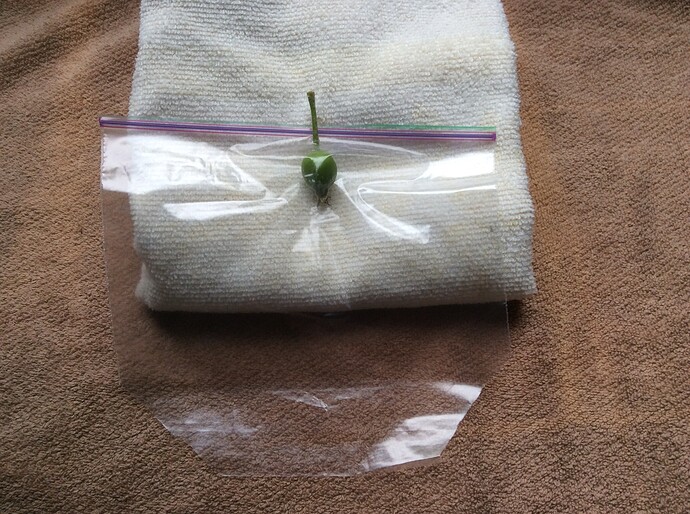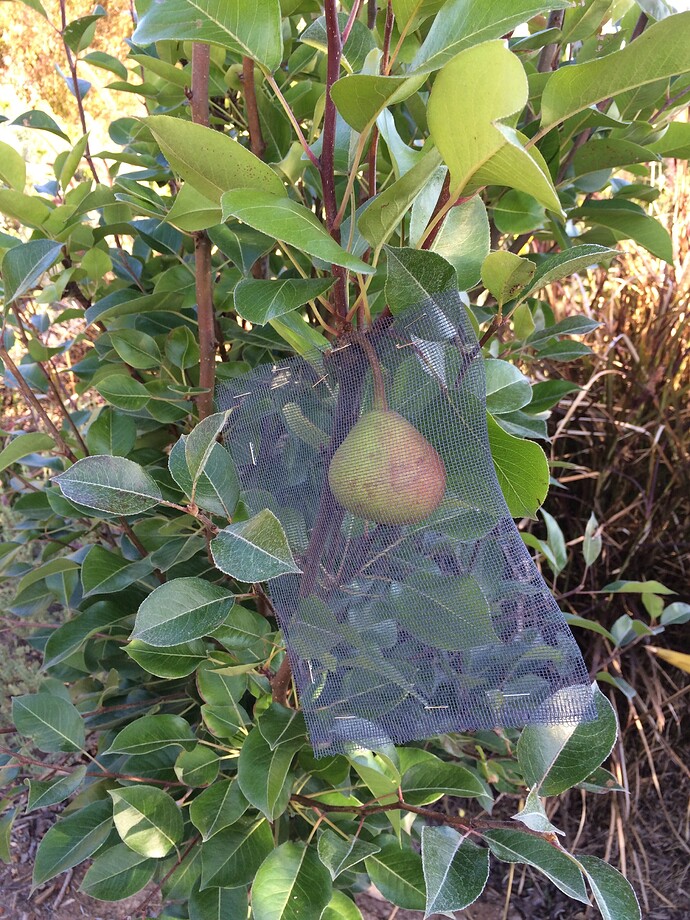@AJfromElmiraNY I was just about to post on that very subject. I got a bunch of organdy bags that someone on here suggested. I’ve got some on my apple tree and some on my pear tree. The pears have very long stems, and a couple of the bagged pears fell off after a few days of strong winds. When I looked carefully at them, it looked like the top of the stem (where they broke off) was browned and twisted. So I think what may have happened was that some of them were at a certain angle to the wind such that they flipped back and forth a lot, eventually breaking off. Kind of like metal fatigue. Others are still fine, and it may just be that they don’t catch the wind in the same way.
No drops here in over a month. Most of my drops were early when the fruit was pea size or smaller. Some dropped from wind and others dropped due to low temperatures. My apples and pears are 1.5-2" now so they should be ok. I’m planning to spray surround a little next season until they get marble size and then bag.
I’m always looking for ways to improve my bagging technique. At what size to you bag the fruit and do you treat/spray prior to bagging? Thanks, Bill
I’ve been using normal sandwich bags- 5.875" x 6.5" and come in boxes of 125. I’ve been doing 50-70 per day for the last ~4 days, with a few more days to go. It is a bit time consuming, but half the time spent is just thinning the fruit.
As Alan mentioned in the thinning thread, it is probably a good idea to start on the apples, before moving on to peaches as it can have a bigger impact on the return crop. So most of my thinning has been on apples and pears so far.
I’ve bagged a few peaches, as it is something I want to give a try this year, after hearing about my dad’s success last year. He is using the smaller bags this year, as he had some issues with the bags coming off with fruit. What he got to stick around was perfect. He is saying that he’ll re-bag later with a larger bag, but that seems like a lot of work to me. But, he is retired and doesn’t have that many peaches to bag (he mentioned ~50 after thinning), so maybe it will work out.
I think the fruit is a bit bigger this year, than some of the past years that I’ve bagged. Even though we got a late start, there has been a lot of sunny weather. It lead to the first strawberries 3-5 days earlier than normal for me.
I sprayed a single coat of Surround about a week and a half before I started bagging, hoping that it would help me have a few fruitlets without PC eggs to choose from. It kind-of worked, but it is quite a pain to examine each fruit before thinning to try to find the new unspoiled ones. It makes thinning take a lot longer. I also collect the fruit and bring it to the garbage, rather than dropping it on the ground and letting the PC pupate.
In terms of how I prepare the bag, I cut the 2 bottom corners off while they are still in a big stack. Then, a few bags at a time I make a single cut into the zipper, not extending much past it. This cut lets me completely close the bag on both sides of the stem. If you try to do a bunch at once, you wind up making the cut too deep and risk the fruit falling out through the resulting hole.
I just started making the zipper cut this year. I think that this cut will help keep the bags in place. In the past, I would routinely lose quite a few as the season went on. It is also quicker to put the bag on, as I only have to open and re-seal half of it.
Is there any chance of seeing a before and after pic to see your fix on the baggie? Thanks
The previous two years I made the zipper cuts and they all stayed snug around the stem. This spring I eliminated this step and just secured the zip around the stem. Without the cut there is not a good seal and some becomes loose and a few does come off. Although I will go back to cutting the zip, the rough cut tends to scar the stem with the constant wind movement. One of my problems is bagging the fruit so soon after petal fall several of my fruit drops for reasons other than the bag. My next round of bagging I would like to let the fruit get a little larger. I think this will eliminate the disappointment of seeing bags drop. Bagging fruit does produce very good no or low spraying results. Best of luck with your bagging, Bill
That is what I meant. I wasn’t sure how many would be lost to this. It sounds like only a small percentage.
Apples stems are harder to pinch off. I use this pruning snip. It is very convenient. I try to bag as soon as I can but sometimes I need to get rid of bigger fruit, too.
I found a paper punch worked well for the stem hole in the zipper. I pre-punched the bags sitting at a table indoors.
Did you use one of the hand squeeze punches or one the three ring binder type? Interesting idea. Thanks, Bill
Hi all, I bag all of my apples and I net my trees. I’ve used baggies successfully for the past five years. This years crop is looking extra large until I start thinning. I didn’t spray Captan last year and sooty blotch and fly speck came through the holes in the bottom of the bags. This year I will spray Captan after my apples are bagged. I have the worse time with my grapes. I bought cotton cloth white bags to cover grape clusters last year and the birds pecked right through the bags and created a mess. What is the best bag for grapes? (these are very fragrant Concords).
Thanks for the pics. I try not to be too slow so pics help 
You only need very tiny snips at the corners for the rain to run out.
Auburn, thank you for describing your experience, It’s really helpful.
Thank you everyone for the helpful comments and experiences on this topic. Your input really expands on the original post,
Pineapple pear tree. So far, the only pear of my 12 or 13 that has bloomed and set fruit. Super easy to do, took me about 4 or 5 minutes to do. Thanks Clint for the great idea. I might actually get to eat the 4 pears my Pineapple pear has set. Going to do this for my Pink Pearl apple tree as well. This is for bird protection, and to some degree, hopefully, squirrel protection. Metal screening material stapled in place.
Patty S.
Patty, I think you will get to eat your pears!
Gosh, Daniel, I sure hope so. Didn’t get one single pear last year 




